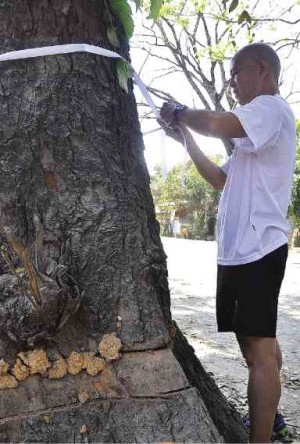Will Pangasinan trees still be saved?

FR. ROBERT Reyes, the “running priest,” ties a white ribbon around a tree that is set to be felled along a section of MacArthur Highway in Binalonan, Pangasinan, to make way for a road-widening project. WILLIE LOMIBAO / CONTRIBUTOR
If only they were asked, the residents of eastern Pangasinan villages would not have agreed to the cutting of trees that lined the MacArthur Highway traversing their communities.
Beatriz Bugayong, 70, who lives in Barangay (village) Sumabnit in Binalonan town, said no one came to ask the residents about it. She only learned from a group of men who came one day that the huge tamarind tree she herself planted 20 years ago near the road shoulder in front of her house would be felled.
The tree was getting in the way of a road-widening project, she was told.
“Sayang (It’s such a waste). It bears a lot of fruits. All I asked from them was to give me the branches of the trees for our firewood,” Bugayong said.
Sharing her sentiments are thousands of people living along the 42-kilometer stretch of the MacArthur Highway from the towns of Rosales, Villasis, Binalonan, Pozorrubio and Sison to Urdaneta City.
The trees provided protection from the sun to them, especially to pupils who walk every day to school, as well as beauty to the communities.
Consultation
Fernando Estrada, head of community environment and natural resources office in
Urdaneta, has insisted that the residents were consulted through the municipal and city councils.
The Department of Environment and Natural Resources (DENR) regional office in San Fernando City, La Union province, granted the Department of Public Works and Highways (DPWH) the permit to cut the trees after it complied with all the requirements, Estrada said.
“They (municipal and city councils) submitted resolutions interposing no objection to the tree cutting,” he said during a dialogue with representatives of environmental groups last month.
Since November, however, more than 1,000 of the 1,829 trees marked for cutting had been felled. Of the 770 trees still standing, the DPWH said it would spare 225 following mounting criticisms.
Extension
Had the 90-day tree-cutting permit not expired in February, all of the trees would have been cut by now. The DPWH has asked for an extension of the permit, but this has been likewise opposed by environmentalists, who come from Pangasinan and as far as Metro Manila.
Proponents of the road-widening project have been pushing as hard for the project to get through.
Former Pangasinan Rep. Mark Cojuangco, who initiated the project, said the trees were not supposed to be inside the road’s right of way because they posed danger to motorists. “If we widen the paved portion of the national highway, the trees would become big public hazard,” he said.
Right place for trees
“So, I invite all these people. Let’s look at trees again, but let’s plant them in the right place. And let’s spend money for the right place for the trees,” Cojuangco said.
He said the road-widening project would be delayed again if the DENR denied the DPWH an extension of its tree-cutting permit.
“We went through the legal process when we applied for [a special tree-cutting] permit. We waited for three years before the permit was granted. And now that the project is here, they want us to wait again? It could be stopped again,” he said.
Unity walk
Local mayors, government and barangay officials and employees dramatized their support for the project by staging a unity walk on MacArthur Highway in their towns on March 11, stopping traffic for a few minutes along the busy national road.
This was done a day after the provincial board wrapped up its “Question Hour,” where concerned government agencies and environmental groups were invited to shed light on the tree-cutting activities.
Left unanswered, however, is the nagging question: Can the 545 remaining trees be saved?
The only chance, it seems, is for the DENR to deny the DPWH bid for a prolonged tree-cutting permit.
Girdling
The remaining trees have all been girdled or stripped of a portion of their barks around their trunks. Girdling cuts the flow of nutrients to the tree and, without timely intervention, will eventually kill it.
“Girdling is very malicious. It’s like injecting the first lethal injection to a convict. It is like starting the execution,” Fr. Robert Reyes, known as the “running priest,” had said after attending the provincial board’s hearing.
Tree surgery
But a procedure called “tree surgery” will heal the wounds inflicted on the trunks, said forestry expert Roger Guzman, executive director of the Philippine Federation of Environmental Concern.
It is now up to the provincial board to decide on the fate of the remaining trees. Before closing the hearing on March 10, the board’s presiding officer, Vice Gov. Ferdinand Calimlim Jr., said: “We do not only take care of the trees but look at everything, including our rivers and forests. We are doing our best to strike a balance between caring for the environment and development projects.”














